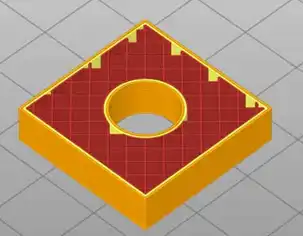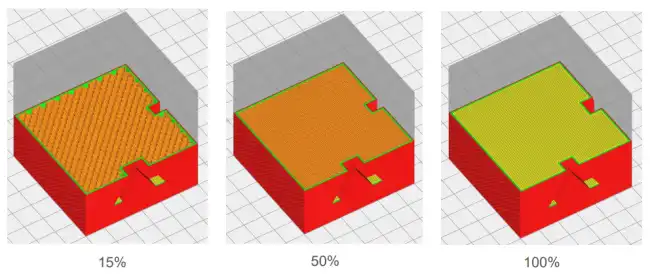The infill is the internal filling of a 3D printed piece, which is generated to provide strength and rigidity without the need to use an excessive amount of material.
Imagine you are printing a cube. If you print it completely solid, you will use a lot of material, and it will take a long time to print.
When we print an object, it is not always necessary for it to be completely solid (in fact, in most cases, it is not).

By printing the piece partially hollow, we can significantly reduce print time and material consumption while maintaining a good part of the strength and rigidity in the piece.
Infill is important for several reasons:
- Strength and rigidity: Infill provides the internal structure necessary for the piece to be strong and rigid.
- Material consumption: It allows you to significantly reduce the amount of material you use.
- Print time: It reduces print time, as the printer has to deposit less material.
- Weight of the piece: A low-density infill also reduces the weight of the piece.
Infill Density
The infill density is one of the most important factors to consider when talking about infill.
Density refers to the amount of material used for the internal filling of the piece and is expressed as a percentage.
For example, a 20% infill means that 20% of the internal volume of the piece is filled with material, while the remaining 80% is empty.

Logically, the lower the percentage of the piece that we fill with material,
Less material (less time, lower cost, less weight)
But also, less strength of the piece
Choosing the Right Percentage
The choice of infill density depends on several factors, such as the strength you need, print time, and material consumption. Here are some general guidelines:
Low density (0-20%): For decorative pieces or quick prototypes, where strength is not critical. These pieces will be light and quick to print.
Medium density (20-50%): Used in functional pieces that require a combination of strength and lightness. It is a good option for objects that must support moderate loads.
High density (50-100%): Recommended for pieces that must withstand heavy loads or impacts. These pieces will be heavier and take longer and more material to print, but they will provide maximum strength.
The 70-99% range should be avoided. It does not provide significant material advantages compared to the time/material savings factor (due to stress concentrators).
For example, if you are going to fill to 90%, you might as well fill directly to 100%
Types of Infill
Another parameter is the geometry of the infill that we are going to make. There are several types of infill, each with its own characteristics and applications. Let’s look at the most common:
Straight infill, also known as Grid, is one of the simplest and most common patterns.
It consists of a series of straight lines that intersect at right angles, forming a grid.
This type of infill is easy to print and provides good strength in all directions.
Triangle infill is similar to straight infill, but instead of straight lines, it uses triangles.
This pattern provides greater strength than straight infill, especially in applications where the piece is subjected to forces in different directions.
Hexagon infill, also known as Honeycomb, is one of the most efficient patterns in terms of strength and material consumption.
Hexagons are a very stable geometric shape, making this type of infill ideal for pieces that require high strength with minimal material.
Cubic infill is a three-dimensional pattern that provides uniform strength in all directions.
This type of infill is ideal for pieces that are subjected to forces in multiple directions, as it provides a very stable internal structure.
Gyroid infill is a very interesting three-dimensional pattern. It consists of a series of curved surfaces that intertwine, forming a very strong and lightweight structure.
This type of infill is ideal for pieces that require high strength with minimal material.
In general, the most common and straightforward is the straight infill. It is usually not necessary to change it.